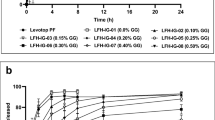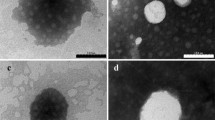Abstract
The field of ocular drug delivery is one of the interesting and challenging endeavors facing the pharmaceutical scientist. Novel approaches for ophthalmic drug delivery need to be established to increase the ocular bioavailability by overcoming the inherent drawbacks of conventional dosage forms. In situ hydrogels are instilled as drops into the eye and undergoes a sol-to-gel transition in the cul-de-sac, improved ocular bioavailability by increasing the duration of contact with corneal tissue, thereby reducing the frequency of administration. The purpose of the present work was to develop an ophthalmic drug delivery system using three different gelling agents with different mechanisms for in situ gelation of Moxifloxacin hydrochloride, a fluoroquinolone antibiotic. polyox (a pH-sensitive gelling agent), sodium alginate (an ion-sensitive gelling agent), and poloxamer (a temperature-sensitive gelling agent) were employed for the formation of in situ hydrogel along with HPMC K4M as viscofying agent, which increases the residence time of the drug in the ocular cavity. The promising formulations MF4, MF5, and MF9 were evaluated for pH, drug content, in vitro gelation, in vitro drug release, in vivo drug release, ocular irritation, and stability. Percent drug content of 98.2, 98.76, and 99.43%; viscosity of 15.724 × 100, 16.108 × 100, and 15.213 × 100 cP at 20 rpm, cumulative percent release of 75.364, 74.081, and 71.752%, and C max of 1,164.16, 1,187.09, and 1,220.58 ng/ml was observed for formulation MF4, MF5, and MF9, respectively. The developed formulations were therapeutically efficacious, stable, and non-irritant and provided sustained release of the drug over 8 h.



Similar content being viewed by others
References
Blondeau JM (2004) Fluoroquinolones: mechanism of action, classification, and development of resistance. Surv Ophthalmol 49:S73–S78
Cohen S, Lobel E, Trevgoda A, Peled Y (1997) A novel in situ forming ophthalmic drug delivery system from alginates undergoing gelation in the eye. J Control Release 44:201–208
Jain GK, Jain N, Pathan SA, Akhter S, Talegaonkar S, Chander P, Khar RK, Ahmad FJ (2010) Ultra high-pressure liquid chromatographic assay of moxifloxacin in rabbit aqueous humor after topical instillation of moxifloxacin nanoparticles. J Pharm Biomed Anal 52:110–113
Jarvinen K, Tomi J, Urttia SA (1995) Ocular absorption following topical delivery. Adv Drug Deliv Rev 16:3–19
Jeong B, Kim SW, Bae YH (2002) Thermosensitive sol–gel reversible hydrogels. Adv Drug Deliv Rev 54:37–51
Liu Z, Li J, Nie S, Liu H, Ding P, Pan W (2006) Study of an alginate/HPMC-based in situ gelling ophthalmic delivery system for gatifloxacin. Int J Pharm 315:12–17
Manjappa AS, Nanjawade BK, Manvi FV, Murthy SR (2009) Sustained ophthalmic in situ gel of ketorolac tromethamine: rheology and in vivo studies. Drug Deliv Res 69:1–8
Mansour M, Mansour S, Mortada ND (2008) Ocular poloxamer-based ciprofloxacin hydrochloride in situ forming gels. Drug Dev Ind Pharm 34:744–752
Martinez M, McDermott P, Walker R (2006) Pharmacology of the fluoroquinolones: a perspective for the use in domestic animals. Vet J 172:10–28
Meqi SA, Deshpande SG (2002) Ocular drug delivery: controlled and novel drug delivery. CBS Publishers, New Delhi, pp 82–84
Nanjwade BK, Manvi FV, Manjappa AS (2007) In situ-forming hydrogels for sustained ophthalmic drug delivery. J Control Release 122:119–134
Olejnik O (1993) Conventional systems in ophthalmic drug delivery. In: Mitra AK (ed) Ophthalmic drug delivery systems. Marcel Dekker, New York, pp 179–193
Sasaki H, Yamamura K, Nishida K, Nakamurat J, Ichikawa M (1996) Delivery of drugs to the eye by topical application. Prog Retin Eye Res 15:553–620
Silver LH, Woodside AM, Montgomery DB (2005) Clinical safety of moxifloxacin ophthalmic solution 0.5% (vigamox) in pediatric and nonpediatric patients with bacterial conjunctivitis. Surv Ophthalmol 50:S55–S63
Srividya B, Cardoza RM, Amin PD (2001) Sustained ophthalmic delivery of ofloxacin from a pH triggered in situ gelling system. J Control Release 73:205–211
Netland PA (2007) Glaucoma medical therapy, principles and management. 2nd Ophthalmic Monograph 13:11–14
Acknowledgments
We are very grateful to the Vice-Chancellor and Registrar of K.L.E. University and also would like to thank Managing Director and CEO of Dr. Prabhakar Kore Hospital and Research Centre, Belgaum for providing constant support and enthusiasm to carry out this work.
Author information
Authors and Affiliations
Corresponding author
Rights and permissions
About this article
Cite this article
Nanjwade, B.K., Deshmukh, R.V., Gaikwad, K.R. et al. Formulation and evaluation of micro hydrogel of Moxifloxacin hydrochloride. Eur J Drug Metab Pharmacokinet 37, 117–123 (2012). https://doi.org/10.1007/s13318-011-0070-9
Received:
Accepted:
Published:
Issue Date:
DOI: https://doi.org/10.1007/s13318-011-0070-9




